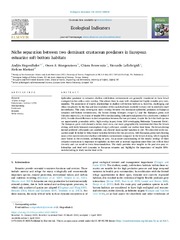Niche separation between two dominant crustacean predators in European estuarine soft-bottom habitats
Permanent lenke
https://hdl.handle.net/10037/24726Dato
2022-04-05Type
Journal articleTidsskriftartikkel
Peer reviewed
Forfatter
Siegenthaler, Andjin; Wangensteen, Owen S.; Benvenuto, Chiara; Lollobrigidi, Riccardo; Mariani, StefanoSammendrag
Epibenthic predators in estuarine shallow soft-bottom environments are generally considered to have broad ecological niches with a wide overlap. This allows them to cope with abundant but highly variable prey communities. The assessment of trophic relationships in shallow soft-bottom habitats is, however, challenging and often complicated by the bias and low resolution of the analytical tools available to study diet in relatively small invertebrates. This study investigates niche overlap between two dominant epibenthic predators in European estuarine soft-bottom environments, the brown shrimp (Crangon crangon L.) and the European green crab (Carcinus maenas L.), by means of trophic DNA-metabarcoding with universal primers for cytochrome c oxidase I (COI). Results show differences in diet composition between the two predators, despite the fact that both species are opportunistic generalists with a high overlap in prey items (218 overlapping Molecular Taxonomic Units). The European green crab showed a richer, more even, and more geographically consistent diet than the brown shrimp, with fairly balanced consumption of algal, arthropod, annelid and mollusc food items. The brown shrimp instead preferred arthropods and annelids, and showed more spatial variation in diet. The observed niche separation could be linked to behavioural variation between the two predators, with European green crab showing more active movements over shallow soft-bottom environments compared to the brown shrimp, which regularly stays buried in the sediment, ambushing its prey. An accurate understanding of the trophic ecology of these estuarine crustaceans is important to capitalise on their role as sentinel organisms since their diet reflects local diversity and can result in toxin bioaccumulation. This study provides new insights in the predator–prey relationships and food web dynamics in European estuaries and highlights the importance of trophic DNA-metabarcoding to study marine food webs.
Forlag
ElsevierSitering
Siegenthaler A, Wangensteen OS, Benvenuto C, Lollobrigidi, Mariani S. Niche separation between two dominant crustacean predators in European estuarine soft-bottom habitats. Ecological Indicators. 2022;138Metadata
Vis full innførselSamlinger
Copyright 2022 The Author(s)


 English
English norsk
norsk